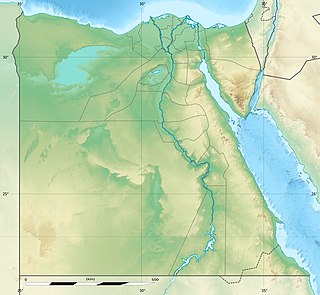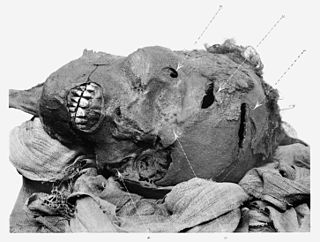Related Research Articles

Thebes, known to the ancient Egyptians as Waset, was an ancient Egyptian city located along the Nile about 800 kilometers (500 mi) south of the Mediterranean. Its ruins lie within the modern Egyptian city of Luxor. Thebes was the main city of the fourth Upper Egyptian nome and was the capital of Egypt for long periods during the Middle Kingdom and New Kingdom eras. It was close to Nubia and the Eastern Desert, with its valuable mineral resources and trade routes. It was a cult center and the most venerated city during many periods of ancient Egyptian history. The site of Thebes includes areas on both the eastern bank of the Nile, where the temples of Karnak and Luxor stand and where the city was situated; and the western bank, where a necropolis of large private and royal cemeteries and funerary complexes can be found.

Tel Abel Beth Maacah, Arabic name: Tell Abil el-Qameḥ, is a large archaeological site consisting of a mound with a small upper northern section and a large lower southern one, connected by a saddle. It is located on the northern border of present-day Israel, about 2 km south of the town of Metulla and about 6.5 km west of Tel Dan.

Ahmose I was a pharaoh and founder of the Eighteenth Dynasty of Egypt, classified as the first dynasty of the New Kingdom of Egypt, the era in which ancient Egypt achieved the peak of its power. He was a member of the Theban royal house, the son of pharaoh Seqenenre Tao and brother of the last pharaoh of the Seventeenth dynasty, Kamose. During the reign of his father or grandfather, Thebes rebelled against the Hyksos, the rulers of Lower Egypt. When he was seven years old, his father was killed, and he was about ten when his brother died of unknown causes after reigning only three years. Ahmose I assumed the throne after the death of his brother, and upon coronation became known as nb-pḥtj-rꜥ "The Lord of Strength is Ra".

Memphis or Menefer was the ancient capital of Inebu-hedj, the first nome of Lower Egypt that was known as mḥw ("north"). Its ruins are located near the modern town of Mit Rahina, 20 km (12 mi) south of Giza in Greater Cairo, Egypt.

Hyksos is a term which, in modern Egyptology, designates the kings of the Fifteenth Dynasty of Egypt. The seat of power of these kings was the city of Avaris in the Nile delta, from where they ruled over Lower and Middle Egypt up to Cusae. In the Aegyptiaca, a history of Egypt written by the Greco-Egyptian priest and historian Manetho in the 3rd century BC, the term Hyksos is used ethnically to designate people of probable West Semitic, Levantine origin. While Manetho portrayed the Hyksos as invaders and oppressors, this interpretation is questioned in modern Egyptology. Instead, Hyksos rule might have been preceded by groups of Canaanite peoples who gradually settled in the Nile delta from the end of the Twelfth Dynasty onwards and who may have seceded from the crumbling and unstable Egyptian control at some point during the Thirteenth Dynasty.

The New Kingdom, also referred to as the Egyptian Empire, is the period in ancient Egyptian history between the sixteenth century BC and the eleventh century BC, covering the Eighteenth, Nineteenth, and Twentieth dynasties of Egypt. Radiocarbon dating places the exact beginning of the New Kingdom between 1570 BC and 1544 BC. The New Kingdom followed the Second Intermediate Period and was succeeded by the Third Intermediate Period. It was Egypt's most prosperous time and marked the peak of its power.

Tel Megiddo is the site of the ancient city of Megiddo, the remains of which form a tell, situated in northern Israel near Kibbutz Megiddo, about 30 km south-east of Haifa. Megiddo is known for its historical, geographical, and theological importance, especially under its Greek name Armageddon. During the Bronze Age, Megiddo was an important Canaanite city-state and during the Iron Age, a royal city in the Kingdom of Israel.

Avaris was the Hyksos capital of Egypt located at the modern site of Tell el-Dab'a in the northeastern region of the Nile Delta. As the main course of the Nile migrated eastward, its position at the hub of Egypt's delta emporia made it a major capital suitable for trade. It was occupied from about the 18th century until its capture by Ahmose I.

Pithom was an ancient city of Egypt. Multiple references in ancient Greek, Roman, and Hebrew Bible sources exist for this city, but its exact location remains somewhat uncertain. A number of scholars identified it as the later archaeological site of Tell El Maskhuta. Others identified it as the earlier archaeological site of Tell El Retabeh.

The Giza Pyramid Complex, also called the Giza Necropolis, is the site on the Giza Plateau in Greater Cairo, Egypt that includes the Great Pyramid of Giza, the Pyramid of Khafre, and the Pyramid of Menkaure, along with their associated pyramid complexes and the Great Sphinx of Giza. All were built during the Fourth Dynasty of the Old Kingdom of Ancient Egypt. The site also includes several cemeteries and the remains of a workers village.

Athribis was an ancient city in Lower Egypt. It is located in present-day Tell Atrib, just northeast of Benha on the hill of Kom Sidi Yusuf. The town lies around 40 km north of Cairo, on the eastern bank of the Damietta branch of the Nile. It was mainly occupied during the Ptolemaic, Roman, and Byzantine eras.

Sharuhen was an ancient town in the Negev Desert or perhaps in Gaza. Following the expulsion of the Hyksos from Egypt in the second half of the 16th century BCE, they fled to Sharuhen and fortified it. The armies of Pharaoh Ahmose I seized and razed the town after a three-year siege.

Seqenenre Tao ruled over the last of the local kingdoms of the Theban region of Egypt in the Seventeenth Dynasty during the Second Intermediate Period. He probably was the son and successor to Senakhtenre Ahmose and Queen Tetisheri. The dates of his reign are uncertain, but he may have risen to power in the decade ending in 1560 BC or in 1558 BC. With his queen, Ahhotep I, Seqenenre Tao fathered two pharaohs, Kamose, his immediate successor who was the last pharaoh of the Seventeenth Dynasty, and Ahmose I who, following a regency by his mother, was the first pharaoh of the Eighteenth. Seqenenre Tao is credited with starting the opening moves in a war of revanchism against Hyksos incursions into Egypt, which saw the country completely liberated during the reign of his son Ahmose I.

Senakhtenre Ahmose, or Ahmose "the Elder" was the seventh king of the Seventeenth Dynasty of Egypt during the Second Intermediate Period. Senakhtenre reigned for a short period over the Theban region in Upper Egypt at a time where the Hyksos 15th Dynasty ruled Lower Egypt. Senakhtenre died c.1560 or 1558 BC at the latest.

Seuserenre Khyan was an Hyksos king of the Fifteenth Dynasty of Egypt, ruling over Lower Egypt in the second half of the 17th century BCE. His royal name Seuserenre translates as "The one whom Re has caused to be strong." Khyan bears the titles of an Egyptian king, but also the title ruler of the foreign land (heqa-khaset). The later title is the typical designation of the Hyksos rulers.

El Kab is an Upper Egyptian site on the east bank of the Nile at the mouth of the Wadi Hillal about 80 kilometres (50 mi) south of Luxor. El Kab was called Nekheb in the Egyptian language, a name that refers to Nekhbet, the goddess depicted as a white vulture. In Greek it was called Eileithyias polis, "city of the goddess Eileithyia".

The Eighteenth Dynasty of Egypt is classified as the first dynasty of the New Kingdom of Egypt, the era in which ancient Egypt achieved the peak of its power. The Eighteenth Dynasty spanned the period from 1550/1549 to 1292 BC. This dynasty is also known as the Thutmosid Dynasty for the four pharaohs named Thutmose.

Tel Michal is an archaeological site on Israel's central Mediterranean coast, near the modern city of Herzliya, about 6.5 kilometres (4.0 mi) north of the Yarkon River estuary and 4 kilometres (2.5 mi) south of Arsuf-Appolonia. Excavations have yielded remains from the Middle Bronze Age to the Early Arab period.

Tell Nebesha or Nebesheh is an archaeological site in Egypt, and the location of the ancient city of Imet. It is found around 10km south of Tanis in the Eastern Nile Delta. This was the ancient capital of the 19th Nome of Lower Egypt. By the Assyrian period, it was succeeded by Tanis.
Abattoir Hill, pronounced in Hebrew as Giv'at Bet Hamitbahayim, is an archaeological site in Tel Aviv, Israel, located near the southern bank of the Yarkon River. The site is a natural hill made of Kurkar, a local type of sandstone. In 1930 ancient burials and tools were discovered upon the construction of an abattoir on top of the hill, hence its name. Between 1950 and 1953, Israeli archaeologist Jacob Kaplan studied the site, ahead of the construction of new residential units and streets on it. He discovered the remains of burials and small settlements spanning from the Chalcolithic period to the Persian period. In 1965 and 1970 Kaplan conducted two more excavations next to the slaughterhouse and discovered settlement remains from the Bronze Age and the Persian period. In February 1992 a salvage excavation was conducted by Yossi Levy after antiquities were damaged by development works. Two burial tombs dated between the Persian period and the Early Arab period were discovered. In June 1998 another salvage excavation was conducted by Kamil Sari after ancient remains were damaged by work of the Electric Corporation. Two kilns were unearthed, similar to two found by Kaplan.
References
- ↑ Elsayed Abdel-Alimː Tel Habuaː new discoveries from the Saite Period, in Egyptian Archaeology 56, Spring 2020, p. 10
- ↑ Hyksos buildings discovered at the Tel Habuwa dig at News Network Archaeology
- ↑ "Hyksos buildings are the latest ancient discovery in Tel Habuwa - Ancient Egypt - Heritage". Ahram Online.
- ↑ Elsayed Abdel-Alimː Tel Habuaː new discoveries from the Saite Period, in Egyptian Archaeology 56, Spring 2020, p. 10-11